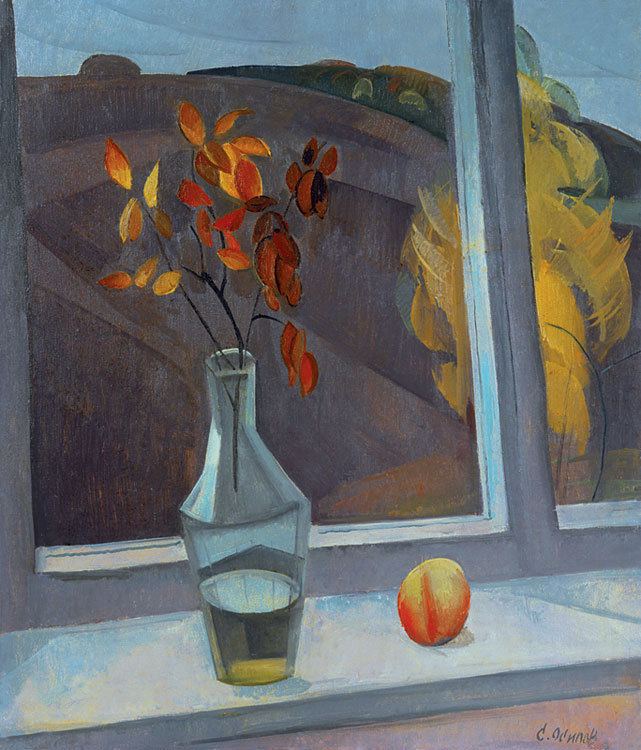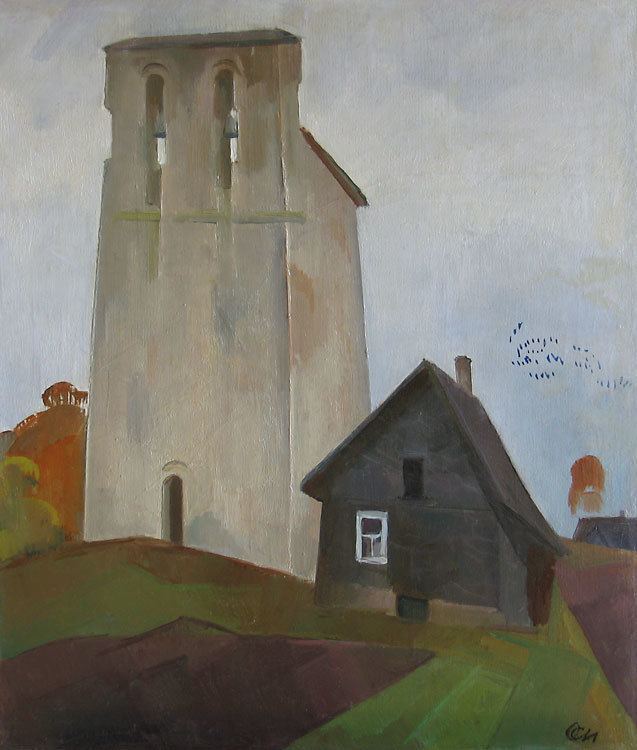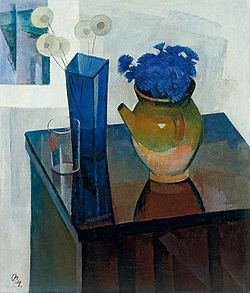Nationality Russian Role Artist | Name Sergei Osipov Movement Realism Period Realism | |
 | ||
Died October 12, 1985, Saint Petersburg, Russia Known for Painting, Visual arts education | ||
Osipov Sergei (1915 - 1985), Leningrad artist
Sergei Ivanovich Osipov (Russian: Серге́й Ива́нович О́сипов; September 22, 1915, Stepankovo, Bezhetsk county, Tver Province, Russian Empire – 1985, Leningrad, USSR) was a Soviet Russian painter, graphic artist, and art teacher, who lived and worked in Leningrad, and also was a member of the Leningrad branch of Union of Artists of Russian Federation. He had been regarded as one of the leading representatives of the Leningrad school of painting, most famous for his landscape and still life paintings.
Contents

Biography

Sergei Ivanovich Osipov was born September 22, 1915 in the village of Stepankovo, Bezhetsk county, Tver Province, Russian Empire. His father worked on construction in Petrograd.

Osipov started his education in primary school of the village of Porechie. In 1927 he coming to his father in Leningrad. Here he graduated seven classes of secondary school № 57 and enters a pupil at the plant. Then he works with his father in construction. At the same time Osipov attending evening classes of Tavricheskaya Art School, where he studied with famous teachers Vladimir Sukov and Semion Abugov.

In 1932, Sergei Osipov entered the preparatory classes at the Russian Academy of Arts, and in 1936 he became a student of painting department of the Leningrad Institute of Painting, Sculpture and Architecture. He studied of Semion Abugov, Mikhail Bernshtein, Genrikh Pavlovsky.
The Great Patriotic War caught Sergei Osipov on graduate course of Alexander Osmerkin workshop. He volunteered to go to the Red Army and participated in battles at Leningrad. In December 1941, under the demining of passes for the upcoming battalion sailors from Kronshtadt to the Old Peterhoff he was seriously injured, lost a leg. More than a year he spent in the hospital for treatment. He discharged in 1943 as a disabled of Great Patriotic War. He was awarded the Order of Glory III degree, medals "Medal "For the Defence of Leningrad"" and "For Victory over Germany".
In 1943 Sergei Osipov returned to his studies and graduated of the Leningrad Institute of Painting, Sculpture and Architecture in Alexander Osmerkin workshop. His graduation work was painting named "Partisans", dedicated to the guerrilla struggle against the Nazis in occupied territory of the Soviet Union.
In 1945 begins a multi-year teaching job Sergei Osipov, first at the Tavricheskaya Art School, then in the years 1946-1949 in the Art Studio at the Palace of Culture named after Maxim Gorky. From 1949 until the end of 1970 Osipov taught at the Department of General painting of the Leningrad Higher School of Art and Industry named after Vera Mukhina.
At the same time since 1944, Sergei Osipov begins to work on contracts as painter with Lenizo. In April 1945 he was taken as a member of the Leningrad Union of Soviet Artists. From the same year he began to participate in art exhibitions. He painted landscapes, genre scenes, still lifes, gradually restoring lost during the war skills. Later his art has been shown on the solo exhibitions in Moscow (1983) and in Leningrad (1990).
Creativity Sergei Osipov was inseparably linked with the theme of Motherland - Tver land, its nature, the ancient Russian city, the peasant way of life. Since the late 1940s each year and often several times he visited Staritsa, Torzhok, Pskov, Old Ladoga as well as a House of creativity «Staraya Ladoga», Izborsk, imported from these trips numerous studies, sketches and paintings. Then his work continued in the city art studio. And so, year after year for over forty years. This traveling enriched Osipov invaluable lessons of the ancient builders of temples and forts, whose hands, intuition, and artistic tastes have created a rare beauty. Only then did he realize that the ravines, hills, ridges, river beds, trees, houses must be depicted as structural elements of the environment as small elements of an overall coherent picture of the world, expressing its essential features. Only after this appeared in landscapes of Sergei Osipov Russian soft melody, a clear rhythm, and unique proportions, which we correctly recognize the national character of the landscape.
His recognizable individual style Sergei Osipov took on gradually. By the end of 1950 in technical terms he was a well established as a master. This is evidenced by the works shown in major exhibitions: "The Gathering" (1950), "On the Volga River" (1951), "Last Snow" (1954), "Reaping field" ( 1954), "On the Volkhov River" (1955), "A Little Brook" (1956), "After the Rain" (1957), "The Old Ladoga", "A Bridge over Pskova River", "Pskov. Gremyachaya Tower" (all 1958), "The Saint George's Cathedral in Old Ladoga", "Pskov Courtyard", "Dovmant fortress" (all 1958), "Boats", "The Bridge" (both 1960), and others. But the mere follow to nature no longer satisfied the artist. He need to go further. But how, in what way?
The answer on this question is the painting of the early 1960s: "Outskirts of Village" (1960), "Still Life with Violin" (1960), "In the Old Ladoga" (1961), "Pskov", "Pskov Street" (1962), "Truvor fort" (1962), "Fortress tower", "A Rick. Autumn", "Fortress in Old Izborsk" (all 1963), "Haymaking" (1964), and others. Of particular importance to them play composition. Increasingly, Sergei Osipov invent composition of painting, inhabiting its previously peeped in life and nature.
By simplifying and light deformation of objects, Sergei Osipov emphasizes their three-dimensional structure, and internal force, the stress with which they have been created nature or man. "We must remind the viewer about the latent energy which filled every thing, - said the artist. - For me just here is a real hidden source of poetry, rather than in stories about the activities or events."
Indeed, in his canvases nothing "happens." But they come alive traditions, tastes, manners folk, they can feel our connection with life past generations.
Another notable feature of his art become more abstract forms and the entire composition of the painting, a marked tendency to generalize, allegory, the desire to get away from naturalism to the contemplative and philosophical depth.
The top of the Osipov's creation falls on the 1970 - early 1980s. During this period he created a number of outstanding works, mainly in the genre of still life and landscape. Among them "Still Life with a Balalaika" (1970), "A House with Arch" (1972), [[:|"Autumn branch"]] (1974), "Staritsa town in winter" (1974), [[:|"Still Life with White Jug"]] (1975), "Cornflowers" (1976), "A Forest River" (1976), [[:|"Izborsk's slopes"]] (1978), "Small rick in rainy day" (1981), [[:|"Early greens"]] (1982), "Dandelions" (1985), and others. His style of this time similar of a light semi-Cubism. These paintings are nominated Osipov of the leading artists of the Leningrad school, who made his own contribution to its identity and significance.
Sergei Ivanovich Osipov died on October 12, 1985 in Leningrad at the seventieth year of life. His paintings reside in State Russian Museum, in other Art museums and private collections in Russia, France, USA, England, Finland, and others.
